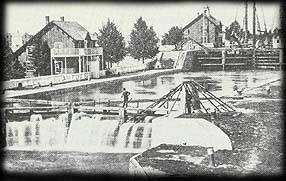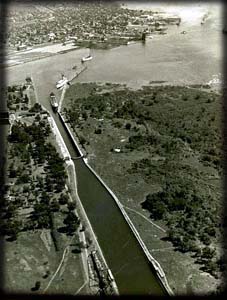|
|
The Sault Ste. Marie Ship Canal officially opened to traffic in September 1895. It completed the last link in an all Canadian waterway along the Great Lakes-St. Lawrence River system. As part of an important commercial highway, the canal facilitated the movement of raw materials from the west to markets in the east and beyond as well as the movement of people and products westward. For more information on ship canals and the Great Lakes-St. Lawrence River system visit the following website at www.seaway.ca
An innovative emergency swing dam to control the flow of water through the canal in the event of an accident was located at the upper entrance. Electrical power to operate the motors was generated in the Powerhouse adjacent to the lock. Most of the other buildings necessary to operate the site were built from the local red sandstone, which together with the formal landscaped grounds, created a distinctive government presence in the city. Its open space and setting has been highly valued and appreciated by residents and visitors to the city for 100 years. From the day of its official opening the Canal was a success and proved its importance as a vital link in the national transportation system. Gradually the site was enhanced and other buildings added to support the operation of the canal.
In 1987 the Canal was declared to be a national historic site. COMMEMORATIVE INTENT Commemorative Intent identifies the reasons why the site was commemorated as being of national historic significance. While the authority to designate a National Historic Site rests with the Minister of Canadian Heritage, it is on the advice of the Historic Sites and Monuments Board of Canada that this authority is exercised. Commemorative Intent, is therefore based on the Ministerially approved recommendations of the Board's deliberations. In 1987 the Board recommended that: "As a waterway that is part of Canada Is national canal system, the Sault Ste. Marie Ship Canal is of national historic significance and should he commemorated by plaque only. The Powerhouse, the machinery therein, and the Emergency Swing Dam associated with the Sault Ste. Marie Ship Canal are of national historic and architectural significance and should be commemorated through preservation and interpretation." In addition, the Board recommended that Parks Canada investigate the possibility of having the artifacts (the electrical switchboard, the exciter, the generator and complete hard hat diving outfit) from the Powerhouse, now at the Museum of Science and Technology, returned to the site. Based on the deliberations of the Historic Sites and Monuments Board of Canada, the commemorative intent is as follows: "As one of eight major main line canals of the Great Lakes - St. Lawrence navigation, the Sault Ste. Marie Ship Canal commemorates the role of the waterway as part of Canada's national canal system. Specific resources associated with the canal, have individually been designated as being intrinsically of national historic and architectural significance. These include the Powerhouse, the machinery therein, and the Emergency Swing Dam which are commemorated at this national historic site." RESOURCES THAT SYMBOLIZE OR REPRESENT THE SITE'S NATIONAL HISTORIC SIGNIFICANCE The historic site refers to those lands defined as Sault Ste. Marie Canal National Historic Site. The site consists of all of North St. Marys Island excluding those properties owned by Great Lakes Power and Wisconsin Central Railway, and all of South St. Marys Island up to the middle of the channel separating Whitefish Island a total area of 64 ha. or 160 acres. The nationally significant (level 1) resources at the Sault Ste. Marie Canal National Historic Site are those resources which have been specifically designated or are directly related to the reasons for national significance. They are as follows: Powerhouse The Powerhouse is located at the northeast corner of the lock. It was built in 1894 to provide power to operate the gates and valves of the lock. It is a highly eclectic, classically inspired building, in red sandstone, with limestone quoins, window surrounds and sills with a hipped roof The Powerhouse is built into a slope at the downstream end of the lock to provide a head of water to drive turbines which turned the electric generators and produced electricity to operate the gates and valves. The interior arrangement takes advantage of the break in slope and was able to accommodate the special equipment required to generate hydroelectric power. The Powerhouse represents a significant technological achievement, that being the first application of electricity in the operation of a lock. Despite modifications to the exterior, the removal of the original generating equipment, and the installation of public washrooms the building is still largely intact. The Powerhouse and the hydroelectric power generating equipment now located at the Museum of Science and Technology are level I cultural resources. The Powerhouse is valued for its surviving form, fabric, and function most of which is intact, and the surviving equipment and engineering works associated with hydro electric generation and operation and maintenance of the canal; this includes such features as the penstock, discharge tube, de-watering pumps, turbines, belts, etc. The Powerhouse will be unimpaired and not under threat when the power generating equipment is repatriated, the building is restored and the power generating equipment is repatriated, and the historic values of the Powerhouse is effectively communicated |



